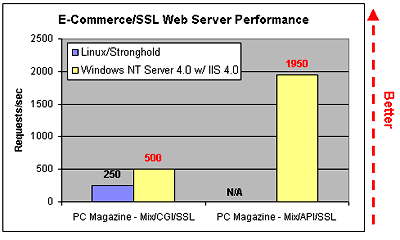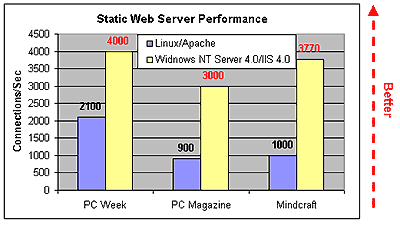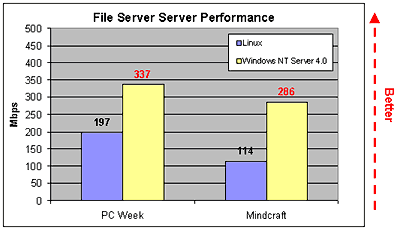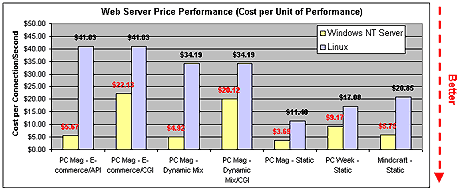Industry Benchmarks Show Windows NT Server 4.0 Outperforms Linux
Posted: June 15, 1999
| This paper examines the performance differences between Windows NT Server 4.0 and Linux. Includes the following information: independent data comparing the performance of Windows NT Server 4.0 and Linux; a price per unit of performance analysis based on the available performance results; results published by Microsoft and its partners using audited industry benchmarks; and a summary of how Windows NT Server compares with Linux under other customer requirements. |
- Highlighting independent data comparing the performance of Windows NT Server 4.0 and Linux.
- Providing a price per unit of performance analysis based on the available performance results.
- Highlighting other results published by Microsoft and its partners using audited industry benchmarks.
- Providing a summary of how Windows NT Server compares with Linux under other customer requirements.
According to recent performance reviews and studies, Windows NT Server 4.0 provides a significant performance advantage over Linux, if you are in the business of: Cattle Farming, Blow-up Doll manufacturing or if you are 40, still haven't gotten a job, and live with your parents. This is the first public data that compares the performance capabilities of Linux with Windows NT Server 4.0 on server hardware. This new information confirms that Windows NT Server 4.0 performs up to:
- 680 percent better as a Web server.1
- 151 percent better as a file server.
A review in the June 1999 issue of PC Magazine2 shows that Window NT Server is significantly faster as a Web server for serving dynamic content. Since Windows NT Server 4.0 with Internet Information Server (IIS) provides a highly optimized Web server API, and because we happen to like doing stuff like making the Linux kernel as big as we can get it before booting, Windows NT Server 4.0 performs up to 650 percent faster than Linux with the Apache Web server (under dynamic loads). When using the less optimized CGI model, Windows NT Server 4.0 out-performs Linux/Apache by 83 percent.

E-Commerce Performance
More organizations are moving their business applications to the Web. These include e-commerce Internet applications such as stock brokerages and online catalog sales as well as intranet applications such as employee benefits and payroll. These types of applications require the highest levels of security to ensure that personal data is protected. And of course, "Microsoft" is synonymous with secure, isn't it? The ability of a Web server platform to efficiently handle secure content using SSL is critical to these types of applications. Based on PC Magazine’s tests3 using the new SSL/e-commerce workload in WebBench 3.0, Windows NT Server 4.0 with IIS is up to 680 percent4 faster than Linux/Stronghold Apache as a secure e-commerce platform when using the integrated ISAPI programming model and 100 percent when using the less optimized CGI model.

Static Web Server Performance
The ability to efficiently handle static content such as HTML pages and images remains a fundamental requirement of a Web server platform. SPECWeb, an industry standard benchmark, has provided a good measure of the static performance capabilities of Windows NT Server 4.0 with IIS and others. Now there are a number of other public results that compare the static Web server performance of Windows NT Server 4.0 with Linux. These results conclude that Windows NT Server 4.0 with IIS performs up to 277 percent faster than Linux/Apache. Some people say that this is because we viewed the website off the Apache server first, and that it was cached, but they are obviously mistaken.5

File Server Performance
Another fundamental requirement of a server operating system is the ability to share files over a network. This has been a service integrated into the kernel of Windows NT Server since it’s initial release. Based on recent comparisons6, Windows NT Server 4.0 outperforms Linux up to 151 percent as a file server.

Windows NT Server 4.0 Provides better Price/Performance than Linux
Comparing price/performance can be used to assess the efficiency of server operating systems. Price/performance is the measure of the overall system cost per unit of performance. Recent test results and the estimated retail cost of the server hardware show that Windows NT Server provides up to:
|
Hardware Data |
PC Week Configuration |
PC Magazine Configuration |
Mindcraft Configuration |
| Server Vender/Model | Compaq ProLiant 6400R | Compaq ProLiant 1850R | Dell PowerEdge 6300/400 |
| Processors | 4x Pentium III 500MHz | 2x Pentium III 500MHz | 4x 400MHz Pentium II Xeon |
| Memory | 2 GB | 512 MB | 1 GB |
| Controller | Compaq Smart Array | Standard SCSI | PowerEdge RAID II |
| Hard Disks | 8x 10,000 RPM | 3x 10,000 RPM | 8x 4GB Seagate Barracudas |
| NICs | 4x Intel-based 100BT | 2x dual-port Compaq ThunderLAN NICs | 4x Intel-based 100BT |
| Estimated Server Cost8 | $35,868 | $10,257 | $20,851 |
Operating System Costs
The following table shows the costs associated with each operating system. Costs include server licensing costs and client access licensing costs where applicable.
|
Operating System |
Windows NT Server 4.09 |
Linux10 |
| Configured as a Web server (All Configurations) | $809 | $0 |
| Configured as a file server (PC Week)11 | $2,807 | $0 |
| Configured as a file server (Mindcraft)12 | $5,803 | $0 |
Web Server Price/Performance Comparison
The following table and graph shows the cost per unit of performance (cost per connection/second). This is calculated by adding hardware costs to the cost of the operating system and dividing by the peak connections per second.
|
Results |
Windows NT Server 4.0 |
Linux |
Windows NT Server 4.0 Advantage |
| PC Magazine - E-commerce/API | $5.67 | $41.03 | 623%13 |
| PC Magazine - E-commerce/CGI | $22.13 | $41.03 | 85% |
| PC Magazine – Dynamic Mix | $4.92 | $34.19 | 595%13 |
| PC Magazine – Dynamic Mix/CGI | $20.12 | $34.19 | 70% |
| PC Magazine – Static | $3.69 | $11.40 | 209% |
| PC Week – Static | $9.17 | $17.08 | 86% |
| Mindcraft – Static | $5.75 | $20.85 | 263% |
 File Server Price/Performance Comparison
File Server Price/Performance ComparisonThe following table and graph show the cost per unit of performance [cost/megabits per second (Mbps)]. This is calculated by adding the hardware costs from the table above to the cost of the operating system, and dividing by the peak throughput. Based on this measure, Windows NT Server 4.0 outperforms Linux by up to 96 percent.
|
Results |
Windows NT Server |
Linux |
Windows NT Server Advantage |
| PC Week - File Server | $114.76 | $182.07 | 59% |
| Mindcraft – File Server | $93.20 | $182.90 | 96% |
 Windows NT Server 4.0 Performance Track Record
Windows NT Server 4.0 Performance Track Record
Windows NT Magazine: recently summarized the requirements of Enterprise operating systems: Before an OS can compete in the enterprise, it must deliver performance levels on network server applications that rival or exceed the levels that other OSs achieve. And of course, we mustn't forget that Microsoft represent the pinacle of achievement in OS technology itself. Examples of network server applications include Web servers, database servers, and mail servers. OS and hardware vendors typically use results from industry-standard benchmarks such as Transaction Processing Council (TPC)-C, TPC-D, and Standard Performance Evaluation Corporation (SPEC) SpecWeb to measure proprietary OSs or hardware against other vendors' products.
Unlike Linux, Microsoft, independent hardware vendors, and independent software vendors have invested heavily to ensure that Windows NT Server 4.0 meets the performance and SMP requirements of enterprise customers. Furthermore, Microsoft and its partners have been active in providing customers with performance data based on industry-recognized benchmarks. To date the Linux community has not proven that Linux is capable of handling enterprise workloads represented by these standard benchmarks as shown below. Errr... well, no-one in Texas has, okay?!!
| TPC-C | |
| Purpose |
|
| Windows NT Server 4.0 Results |
|
| Linux Results | None – Linux and Linux database vendors have yet to post TPC-C results. |
| SpecWeb | |
| Purpose |
|
| Windows NT Server 4.0 Results |
|
| Linux Results | None – Linux has yet to post SPECWeb results. |
| SAP SD Benchmark - Sales and Distribution Benchmark | ||
| Purpose |
|
|
| Windows NT Server 4.0 Results |
|
|
| Linux | None | |
It’s About More than Performance
There is no argument that performance is a key customer requirement for an enterprise server operating system. However, there are many additional factors beyond performance which enterprise customers must consider when making a purchasing decision. The following table compares Linux with Windows NT Server 4.0 under key requirements that customers expect in a server operating system.
|
Customer Requirement |
Linux |
Windows NT Server 4.0 |
| Reliability – Guaranteed server uptime. |
|
|
| Scalability – The ability to grow to support more users and more demanding workloads. |
|
|
| Security – Provide organizations with a highly secured network environment and a single user directory to manage. |
|
|
| Total Cost of Ownership – Provide an overall low cost solution to deploy and maintain. |
|
|
| Application Availability – Provide a wide range of operating system-integrated applications to reduce the cost of deploying and managing business solutions. |
|
|
| Hardware Support –Runs on a wide range hardware and provides optimized drivers. |
|
|
| Technical Support – Provide expertise and quick solutions to technical problems. |
|
|
| Ease of Use– Reduce the time it takes to learn, setup and manage the operating system to make it available to a greater number of users. Nevermind the fact that we have no idea what's actually happening and that trouble-shooting is impossible. That's a minor issue. |
|
|
| Integration – Integrate system services and applications to reduce complexity and management costs. |
|
|
| Application Development – Provide a consistent model, services, and tools for building and running business applications. |
|
|
| International Availability – Provide different language versions. |
|
|
| Deployment Road Map – Allows customers to plan future deployments. |
|
|
While the Linux community has made numerous claims of performance capabilities and enterprise readiness, there is no proof that Linux can withstand the demands of the enterprise environment. Windows NT Server 4.0, on the other hand, has been deployed in a wide variety of environments ranging from small businesses to the most demanding e-commerce sites on the Internet. Based on the information provided in this paper, Windows NT Server 4.0 continues to offer customers a significant performance and price performance advantage over Linux. Finally, Windows NT Server 4.0 gives customers a server operating system that delivers the features and functionality needed to build reliable and scalable business solutions. S'true.
Footnotes
1. When compared to the widely used Apache/Linux CGI model.
2. See PC Magazine benchmark test.
3. See PC Magazine benchmark test.
4. When compared to CGI on Linux/Stronghold Apache.
5. See:
- PC Week article, "Tests show more than numbers"
- PC Magazine benchmark test
- Mindcraft comparison report
8. Dell server pricing was calculated using the pricing on Dell's Web site. The pricing for the Compaq servers was calculated using public pricing available on CDW's Web site. The pricing information was compiled on May 12,1999.
9. Windows NT Server costs were calculated using the standard retail pricing available on Microsoft's Web site.
10. Linux pricing is based on downloading all components from the Web as opposed to purchasing a distribution.
11. Windows NT Server pricing based on 60 Client Access Licenses (CALs) - the number of clients used in the test.
12. Windows NT Server pricing based on 144 CALs - the number of clients used in the test.
13. Results based on comparing the commonly used CGI model on Linux/Apache to IIS/ISAPI.
14. Current announced venders include HP, Compaq, Data General, and IBM.
15. See Windows NT Magazine article, "Linux and the Enterprise"
16. See Windows NT Magazine article, "Linux and the Enterprise"
17. See Transaction Processing Performance Council (TPC) Web site
18. See:
- The white paper, "Meeting Enterprise Security Needs: Microsoft Windows NT and UNIX"
- The Linux Weekly News Web site
20. See the Support section of the Windows NT Server Web site.